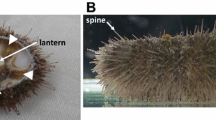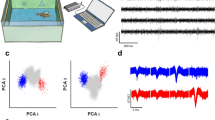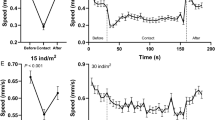Abstract
Regular sea urchins, which have pentaradial symmetry, have been believed to show no preference in which part of the body forward they proceed with. Through use of circular statistics, we show that the regular sea urchin Hemicentrotus pulcherrimus had no preference with respect to what body part, as determined by Lovén’s system, should be anterior in locomotion. The sea urchins, however, preferably proceeded with the body part, which had contacted with the aquarium walls at rest, forward. When the contact part was artificially altered, the body part facing forward in the following proceeding changed accordingly: the animals walked with the part that had contacted last forward. The biological significance of this behavior was discussed in relation to the aggregation formation and homing behavior.



Similar content being viewed by others
References
Batschelet E (1981) Circular statistics in biology. Academic Press, New York
Bernstein BB, Williams BE, Mann KH (1981) The role of behavioral responses to predators in modifying urchins’ (Strongylocentrotus droebachiensis) destructive grazing and seasonal foraging patters. Mar Biol 63:39–49
Blevins E, Johnsen S (2004) Spatial vision in the echinoid genus Echinometra. J Exp Biol 207:4249–4253
Grabowsky GL (1994) Symmetry, locomotion, and the evolution of an anterior end: a lesson from sea urchins. Evolution 48:1130–1146
Hagen N, Andersen A, Stabell O (2002) Alarm responses of the green sea urchin, Strongylocentrotus droebachiensis, induced by chemically labelled durophagous predators and simulated acts of predation. Mar Biol 140:365–374
Holmes SJ (1912) Phototaxis of the sea urchin Arbacia punctulata. J Anim Behav 2:126–136
Hyman LH (1955) The invertebrates: echinodermata, 4.Echinoidea. McGraw-Hill, New York
Parker GH (1922) The geotropism of the sea-urchin Centrechinus. Biol Bull 43:374–383
Parker GH (1936) Direction and means of locomotion in the regular sea-urchin Lytechinus. Mém du Mus Roy d’Hist Nat de Bel, deu sér, Fasc 3:197–208
Snyder N, Snyder H (1970) Alarm response of Diadema antillarum. Science 168:276–278
Yerramilli D, Johnsen S (2010) Spatial vision in the purple sea urchin Strongylocentrotus purpuratus (Echinoidea). J Exp Biol 213:249–255
Yoshida M (1957) Positive phototaxis in Psammechinus microtuberculatus (Blainville). Publ Staz Zool Napoli 30:260–262
Yoshimura K, Motokawa T (2008) Bilateral symmetry and locomotion: do elliptical regular sea urchins proceed along their longer body axis? Mar Biol 154:911–918
Yoshimura K, Motokawa T (2010) Bilaterality in the regular sea urchin Anthocidaris crassispina is related to efficient defense not to efficient locomotion. Mar Biol 157:2475–2488
Acknowledgments
We would like to express thanks to Dr. R. Mizui of Yokohama National University for guiding the habitat of H. pulcherrimus. We are grateful to the staff of Misaki Marine Biological Station for collecting H. pulcherrimus. We would like to express thanks to K. Arita, S. Yogo, and H. Tsurimaki for technical assistance. Supported by the grant-in-aid for Scientific Research from the Ministry of Education, Culture, Sports, Science and Technology, Japan to T.M. (No. 21570075).
Author information
Authors and Affiliations
Corresponding author
Additional information
Communicated by M. Byrne.
Rights and permissions
About this article
Cite this article
Yoshimura, K., Iketani, T. & Motokawa, T. Do regular sea urchins show preference in which part of the body they orient forward in their walk?. Mar Biol 159, 959–965 (2012). https://doi.org/10.1007/s00227-011-1874-5
Received:
Accepted:
Published:
Issue Date:
DOI: https://doi.org/10.1007/s00227-011-1874-5




